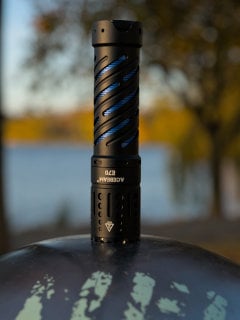So people throw out disposable vapes all the time. I cracked one open to take a look and it turns out they have a 18500 battery in it. So I was thinking of 3D printing a spacer to make it the same size as a 18650 and putting some shrink wrap on them. I just wanted to see what people who know more than me think. Is this a bad idea that is going to burn my house down? a waste of time perhaps?
I did a trial run in my wurkkos fc11 and they seem to work, it charges and looks just as bright.
I would try to search around for a data sheet on that cell to verify its chemistry. For example, CR123 batteries are a lithium based chemistry (LiMnO2) but they’re not normally rechargeable. That doesn’t mean that some companies are putting out lithium ion batteries in that form factor labeled as the original cell type…
Just be wary of them as they are likely unprotected cells.
Batteries made for flashlights will have a protection circuit board on it to protect against over & under voltage and sometimes overheating.
Unprotected batteries do not have a circuit board on them and are usually protected by the device that they are installed into.
You can use them BUT you have to be incredibly careful with them as if things go wrong you will be holding what has essentially become a small pipe bomb.
This is just not true. The circuitry is in the flashlight, not the battery.
There is usually basic over discharge protection in the flashlight circuitry and over charge protection for lights with on light charging.
This usually works in conjunction with the protection circuit on the batteries.
18650 batteries (and other sizes) have become more wide spread because of the increased safety of protected batteries.
The batteries OP wants to use are unprotected cells who’s manufacturer is unknown, actual capacity is questionable and how they have been handled is unknown.
As a rule of thumb flashlights only have LED driver in them and lack any sort of battery protection. Most 18650 batteries that you buy from reputable sources have built-in protection circuits. Cheap cells from ebay et al and recycled cells from old devices are a wildcard, they may or may not have the protection and you need to read the description very carefully or examine the cell in detail to see if it’s protected or not. IIRC, even most lithium cell chargers rely on the cell having built-in protection circuit.
I wouldn’t use unprotected cells for anything that I hold in my hand or put in my pocket/everyday carry. They’re literally marginally stable incendiary devices—I’d feel more safe with a block of C4 in my pocket than an unprotected lithium cell of questionable origin and history.
As a rule of thumb flashlights only have LED driver in them and lack any sort of battery protection.
This hasn’t been true for a quite a while. Most Li-ion flashlights have a low-voltage shutoff.
Most 18650 batteries that you buy from reputable sources have built-in protection circuits.
Also not really true. Top-tier dealers like Illumn and Nkon offer both protected and unprotected options. Some popular flashlights (Zebralight, Emisar/Noctigon) only accept unprotected cells.
even most lithium cell chargers rely on the cell having built-in protection circuit.
No charger anybody should be using relies on that. Correctly charging Li-ion requires tapering current after reaching the target voltage, which can’t happen if it trips a circuit breaker.





